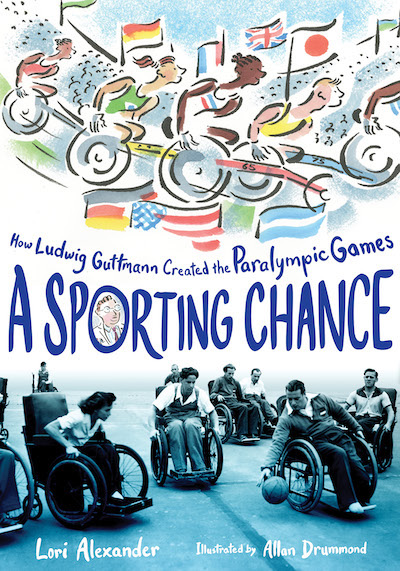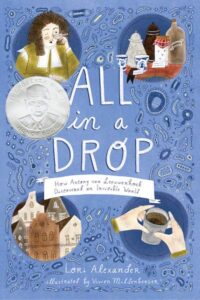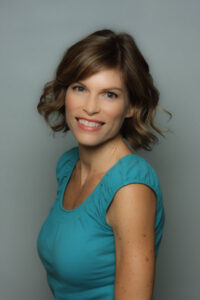
Houghton Mifflin Harcourt | 978-1328580795
Did you know that in 1948, Dr. Ludwig Guttmann organized the first sports competition involving WWII veterans with spinal cord-related injuries? And did you know that twelve years later, in 1960, those very games (called the Stoke Mandeville Games) were played in Rome, Italy and later renamed and recorded as the first official Paralympic Games? And did you know that this year, the games are scheduled to be played in Tokyo, Japan?
Lori Alexander‘s fascinating book – A SPORTING CHANCE, with archival photos and engaging illustrations by Allan Drummond, introduces readers to Dr. Ludwig Guttmann’s pioneering work with patients suffering from spinal cord injuries. Dr. Guttmann’s innovative treatments brought hope and healing to those who had previously faced almost certain death. Listen in as Lori and I chat about her newest book:
- The story of Ludwig Guttman’s journey from working as a volunteer orderly in a local hospital to pursuing medical studies at the University of Breslau, to eventually escaping Nazi Germany for England, where he conducted research on the human nervous system (and later created the Paralympic Games) is both fascinating and a story I’ve never heard told before. How did you come to learn about Ludwig’s work with spinal injuries and what made you know that you were the one to tell his story?
I’m glad you enjoyed reading about Ludwig’s remarkable life, Dianne! Back in 2018, I had just completed my first chapter book biography (ALL IN A DROP) with Houghton Mifflin Harcourt. Coming from picture books, the research, revisions, expert readers, back matter—it was all quite a learning process! But I enjoyed the longer format which allowed me to dig deeper into a topic. When my editor asked if I’d consider doing it all again, I replied, “Absolutely!” But who to write about next? A news story featuring the upcoming Winter Olympics caught my attention. Our family are also big fans of the Paralympic Games. So the spark for A SPORTING CHANCE began with a bit of curiosity and a simple Google search: “Who founded the Paralympic Games?”
was all quite a learning process! But I enjoyed the longer format which allowed me to dig deeper into a topic. When my editor asked if I’d consider doing it all again, I replied, “Absolutely!” But who to write about next? A news story featuring the upcoming Winter Olympics caught my attention. Our family are also big fans of the Paralympic Games. So the spark for A SPORTING CHANCE began with a bit of curiosity and a simple Google search: “Who founded the Paralympic Games?”
My daughter was born with a condition that affects the tibia in her left leg. We didn’t have a diagnosis until she was bearing weight as a newly walking toddler and her leg broke. The bone wouldn’t heal and after six months, her leg was still fractured. In many cases, children with this condition undergo multiple surgeries in attempts to get the affected bone to heal. If the bone won’t fuse, amputation is the next course of action. Although we’ve had some success with surgeries, bone grafts, rodding, and a leg brace, the amputation has always been in the back of our minds. We love to watch the Paralympics to show our daughter (now 14) that legs aren’t required for gold medals. Success comes to those who work for it.
- Let’s talk about your research. Once you decide on your subject matter, what are your first steps? Do you start by reading and gathering information, then gradually begin to formulate a tentative outline? How does your research evolve? In other words, were there questions you had that led to a dead end causing you to have to rethink the sequence, progression, or content of your story? Did you run into any roadblocks – information that you hoped to find, but were unable to? What were some of the challenges of the research? Were there any surprises?
When I learned that a doctor was behind the founding of the Paralympic Games, I had to know more! I read/watched/listened to everything I could find about Ludwig Guttmann—a biography written for adults, newspaper articles, YouTube videos, interviews with athletes, interviews with Ludwig’s grown children, audio recordings made my Ludwig himself. And while I wanted to include every detail from my research, I had to remember my audience—kids aged 8-12. For this chapter book biography, I used a narrative nonfiction format. The remarkable events of Ludwig’s life read like a story, with a main character who has a problem to solve. I like to begin with details from childhood. This gives young readers a hint at what’s to come (Ludwig was small but fast, was smart but didn’t love school, liked to play sports, and stood up for his Jewish friends when they were bullied). Themes of compassion, tenacity, and social justice are woven throughout the story. Ludwig was Jewish and living in Germany up until 1938. So in addition to details about his life, I had to provide historical context to young readers who may not be familiar with this part of world history. It’s a tricky balance for nonfiction writers—we want to keep all the interesting bits and move the story forward without heading off track or making things overly complex (those extra details may fit nicely into sidebars or back matter). The final chapter, which features current Paralympic athletes, was challenging because there were so many women and men, from different countries, participating in different sporting events, that I wanted to include. Narrowing to six “mini-biographies” was a tough task!
- This is your second nonfiction book for middle grade readers. Did your process change much from the first book to the second?
The process didn’t change much, as far as the research and writing. One aspect I found more challenging for A SPORTING CHANCE was the photo acquisitions. The final book includes forty archival photographs, in addition to the colorful illustrations by Allan Drummond. It’s the author’s job to research images, obtain permissions, and pay for any photographs needed. While it was fun combing the internet for possible images, in hindsight I wish I’d been more organized. I found some great options in my early days of research but didn’t make a note of where they came from, which left me hunting for sources months later. I fell in love with a few images but was either denied permissions or could never track down their owner, so they had to be scrapped. The final photographs came from dozens of sources including the US Holocaust Memorial Museum, the International Paralympic Committee, and from research papers Ludwig published in 1947. I went well over my “budget” provided by the publisher but I knew how much kid readers love pictures (I do, too!). So I paid for several extra images out of pocket. What first felt like a daunting task turned out to be a fascinating experience. I had the chance to work with art directors and I felt more connected to the design and layout of the book. In the end, I wouldn’t want the job of photo research to go to anyone else. A picture is worth a bit of your advance!
- Share with readers what you’re working on now and what we can look forward to next!
I’m putting the finishing touches on a third chapter book biography with HMH, called WHAT’S A GERM, JOSEPH LISTER? This one is about the history and science of hospitals and healing before doctors knew anything about germs. Like my previous nonfiction books, it will be highly illustrated. And this one contains plenty of “eew” moments that young readers love. We’re talking about a time when doctors washed their hands after a surgery, not before. Their blood and pus-covered overcoats were never washed. In fact, a stiff, blood-splattered coat was a sign of an experienced doctor. How times have changed! If that’s not your cup of tea, I have a picture book called MINI MIGHTY SWEEPS, featuring a cute street sweeper truck with a can-do attitude, releasing from Harper next summer!
THANKS for sharing your writing process with readers, Lori! WHAT’S A GERM, JOSEPH LISTER?, sounds *very timely* given that we’ve all been especially “germ-focused” over the past year. Having read an early version of MINI MIGHTY SWEEPS, I know readers are in for a treat!

Lori Alexander loves to read and write! She has written picture books like BACKHOE JOE (Harper) and FAMOUSLY PHOEBE (Sterling) as well as the FUTURE BABY board book series (Scholastic). Her first non-fiction chapter book, ALL IN A DROP (HMH) received a Sibert Honor Award. Her new book, A SPORTING CHANCE (HMH), is a Junior Library Guild Selection and received a Kirkus starred review.
Lori resides in sunny Tucson, Arizona, with her scientist husband and two book loving kids. She runs when it’s cool and swims when it’s hot. Then she gets back to reading and writing. Visit Lori at www.lorialexanderbooks.com or on Twitter @LoriJAlexander or Instagram @lorialexanderbooks










